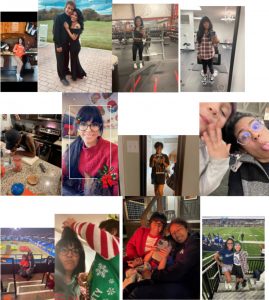Assignment Takeaway 4:
Individual love styles Affect Relationships

Attachment styles vary across individuals by how they form bonds and manage emotions in relationships. What remains the same across individuals is the need for affiliation with others through sustaining relationships. The amount of social connection an individual necessitates depends on the individual. Hendrick and Hendrick designed a self-administered questionnaire entitled Styles of Love composed of 42 questions. Participants average 6 sets of 7 successive answers into subcategories (e.g., Eros, Ludus, Storage, Pragma, Mania, and Agape) and provide narratives for each. After completing the Styles of Love Questionnaire, I learned that my top three love styles are Storage, Eros, and Agape and I am significantly different compared to my female counterpart’s normative scores. The questionnaire designates the high Storage attachment style proposes the essential foundation for a relationship is friendship. Eros lovers demand the “spark” or immediate attraction that peaks your interest. Furthermore, Agape attachment style places their partner’s needs at the forefront of their priorities.
The questionnaire describes the love style of the individual; according to the Similarity-dissimilarity effect, partnerships among similar individuals are more compatible rather than complementary. When partners share common opinions, principles, and interests they evaluate one another more positively. Which means individuals with similar love style scores may respond positively with each other because both partners express love with the same competency.
The Love Style Questionnaire origins can be traced to ‘Colors of Love’ by John Allan Lee, a topic covered in a psychology of sexuality course. In 1973, Lee’s research findings were based on statements and literature suggesting 6 basic components of love (e.g., Eros, Ludus, Storage, Pragma, Mania, and Agape) (Carroll, 2019). Allan suggested partnerships between congruent lovers are more compatible than opposite lovers. Partners with similar colors of love appreciate each other’s reactions and understand the unintended pain caused by one another (Carroll, 2019).
Love and affiliation are relevant to my understanding of mine and my partner’s love styles. Similarities of our love styles enables us to maintain a long-lasting relationship. Rather than if we were in a partnership with s dissimilar partner that is unable to understand our delivery and reception of love.
The visual image I choose is near and dear to my heart. It is a wedding photo of me and my partner. I choose this picture to illustrate how close friendship bloomed into a partnership. Where relationships built on similarities can withstand all that life throws their way. This final piece was truly written from the heart.
References
Carroll, J.L. (2019). Sexuality Now: Embracing Diversity. (6th ed.). Cengage Learning, Inc.
Assignment Takeaway 3:
How Emotions, Thoughts, and Action Can Be Taken to The Extreme.
Social psychology can be applied toward understanding others overt behavior, motives, and intentions. For example, an outburst by Michael Richards toward an African American audience member (YouTube video below). Richards’ behavior brought others to question if the comedian is a racist. The comedian’s word choice aids in deciphering his conscious and/or unconscious thoughts and beliefs. Although Richards’ explicitly uses a racial slur, it is the statement “it was 50 years ago -we’d.” The use of the word “we’d” is significant. When an individual identifies at the intergroup level, they will compare all others who are dissimilar in terms of “out group members.” The “in group” members formed schema uses the heuristic representativeness to classify all others with similar characteristics. The characteristics or categories we place other people in can be positive or negative.
Moreover, our thoughts influence emotions and vice versa; the interplay factors into how we treat those within our environment. In Richards’ case, negative emotions (i.e., anger) influenced him to explode and say what he truly felt. Our overt actions can be linked to an automatic processing through schemas which are preconceived judgments of others. Then our emotions influence our interactions with others in their environment.
However, there are many unknown external factors that could have influenced Richards’ behavior. Where those who are not Michael Richards can fall prey to corresponding biases by negating external factors influencing his reaction. External factors could be that the heckler said something using racial slurs toward the comedian. As a spectator of the 3-minute YouTube video,it is difficult to know the circumstances that lead up to the situation, without being Richards and/or an audience member. But by employing social psychology concepts, insight into the behavior of others, can be understood through a different lens.
I have come to appreciate Social Psychology is cumulative building atop of itself. Where each part is an expansion of previous themes. Social interactions originate within an individual’s cognition and their interpretation of the external environment affects their response to it. As a human and woman of science this knowledge is personally relevant for how I respond to those in my environment. When I use mental short cuts to make decisions about others or identifying at an intergroup level I may be doing so automatically. In heightened situations where negative emotions are present, I can self-regulate by altering my schemas, thoughts, and/or emotions. For example, when my three-year-old’s behavior is “unacceptable” to me. I need to reevaluate the schema I have created in my mind which can alter my emotions and change my behavior. Thereby enabling me to come from a place of understanding.
Two visual images are included. Above depict how social situation affect the cognitive process (thought, emotions, and feelings) and influence behavior. Moreover, the Michael Richards YouTube video is below for a point of reference of the incident with the heckler. Albeit the Michael Richard example represent how emotions, thoughts, classical conditioning, the need to be like can be taken to the extreme.

February 13, 2022
Assignment Takeaway Two:
A Journey To Piece Together ME.

After taking an observer perspective, I assembled an accurate depiction of myself as being compiled of consistent traits to describe my reoccurring behavior. Although this was not always the case. When I compare my present self to my past self, I recognize the improvement I have made recently in my life. In the past I acknowledged the possibility of a more positive future self to transform into the person I am now. The authentic nature of my personality can transcend to differing situations with the use of minor self-enhancement techniques, to touch up my appearance to match the occasion. In the past there were times I had to completely change my identity.
Through this journey I can define myself as a beautifully goofy woman committed to her family, school, and well-being to flourish in life. As a mother I had to stop using painful upward comparisons to the unrealistic idea of a mother that the media portrays. I began engaging in positive self-talk and thinking about controllable factors rather than focusing on external factors that are outside of my control. Moreover, finding a sense of belongingness to a community that shares similar traits and characteristics enhanced my group identity. Where one member’s success helps me feel closer to the group and feel successful too.
The journey I have partaken in has increased my self-esteem and over all well-being and allowed me to live authentically. I have unearthed who I am and realized my actions reflect the person I am and want to be. In addition, I have learned my self-perception can be categorized as a passionate woman important and dedicated. When I view long-term goals abstractly it enables me to increase my self-control to attain them.
The process of self-reflection by taking an observer perspective has unearthed the voyage of finding me. Which is reminiscent of material I have learned in the course Psychology of Adolescents; the development of gaining an understanding of themselves and peers’ identities. The process is initiated by abstract and idealistic thinking, then recognizing their behavior will change in different situations and have different and contradictory self-descriptions depending on the context (Santrock, 2019).
Adolescents expend more time thinking about themselves while also engaging in an unrealistic optimism of the future. Moreover, like adults, teens erroneously engage in upward comparisons to role models with superior capabilities. Which can lead to decreased self-esteem rather than reflecting on their positive achievements. It would appear adolescents and adults are not as dissimilar as we believe.
The ability to take a step back and recognize how stable characteristics produce my behavior in different context brought me closer to understanding the self. By self-reflecting I saw how I grew from not knowing who I was to who I am now. Using the observer perspective to gather information to examine the self. The image I have chosen to visually represent this journey is a collage of ten photos.
References
Santrock, J. (2019). Lifespan development (19th ed.). McGraw-Hill.
January 30, 2022
Assignment Takeaway One:
Positive growth.
As I wrote The About Me and Blog one, it reminded me of the essay I submitted when applying to Old Dominion’s graduate school. Through both papers I was able to find the words to describe my true passion in the field of psychology, where I set my academic goals of conceptualizing how humans interact in the social world. Applying learned material across courses is a huge part of my education. I chose the image of the Monarch flag flying in my office because I see it a symbol of what the future has in store for me.


To make quick decisions to process information, people will employ either through automatic or controlled processing using heuristics (availability, representative, anchoring and adjustments, and/or status quo). As I read through each of them I paused and thought of how I had used each of them throughout my life. When I was a bartender and I met new people, I would use the availability heuristic to make a decision on their employment. I used past experiences with others to make quick judgments based on their appearance. During my Internship with the Research Experience in transportation safety in behavioral sciences, I used the availability heuristic to design a research project. I thought about how I would see a lot of people be distracted by their phones during festivals. I hypothesized pedestrians were more likely to be distracted by their phones during local events. Throughout the project I used the cumulative knowledge of statistics and social perception to explore the occurrence frequency of a phenomenon. With my minor in addiction and prevention, I used previously acquired knowledge to conceptualize the use of anchoring and adjustment heuristics. The alcoholic places a value on drinking and makes adjustments to new information to explain how alcoholics maintain their addiction due to the original anchor. For me to be successful it is important to incorporate previous course material to the subject at hand. I choose to use the picture of pedestrians walking in my research study; it is one of my greatest accomplishments of using the knowledge gained throughout my studies.

The efforts that individuals use to make ourselves more appealing to others is important when other people are using availability heuristics to make quick judgments about you. The other person is taking in the information you are presenting to the world. When individuals try to understand another person, to perceive others accurately we make judgments based on nonverbal communications (i.e., facial expressions, gestures, and body movements). Essentially we take in thin slices of information to form a first impression. These split seconds we interact with others can be paramount to gain advantages in life. Advantages to be hired for a better job, further our education, and meeting important people in our lives. As I prepare for a meet and greet with my advisors for graduate school, it reminds me of all the prep work I need to get done beforehand. I am fortunate to have learned at a young age how important first impressions are. When I was an adolescent my mother enrolled me in etiquette school to study social situations. I am grateful for the experience. I chose my self-portrait because it represents my professional and witty side that I am known for. When I live authentically I am able to show others around me how dedicated and passionate I am to my niche. Learning.
